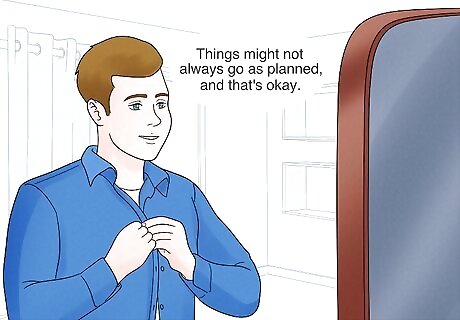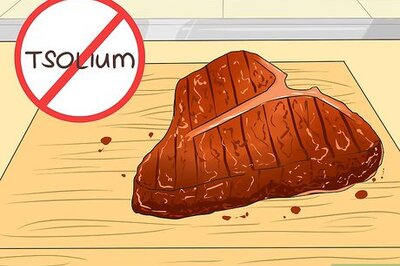
views
Here are 10 ways you can start going with the flow more in your life.
Distract yourself.

Think about something that doesn't stress you out. Maybe it’s a fun memory of you and your family at the beach, or maybe it’s the thought of heading home and eating the ice cream that’s in the freezer. When you feel yourself start to get flustered or anxious, take your mind off your emotions with something good instead. Doing this can help you think more clearly and stop clouding your thoughts with anxiety.
Repeat a mantra to yourself.

Remind yourself to go with the flow. You can use your mantra when you start feeling anxious or worried, or you can start your day out by repeating it to yourself in the mirror. Your mantra can be anything you’d like it to be, but some helpful ones include: “I surrender to the flow and have faith in the ultimate good.” “Things might not always go as planned, and that’s okay.” “I can’t control others, I can only control myself.”
Smile and laugh at your own expense.

Acknowledge how quickly you get flustered. It’s okay to add a little humor into the situation—in fact, it might actually help you feel better! When you notice yourself trying to be controlling or not going with the flow, chuckle to yourself inside and poke a little bit of fun at how you’re acting. You don’t have to let anyone else in on the joke. It’s fine to make fun of yourself, but it’s not so great to hear it from others.
Be agreeable and cooperative.

Let other people run the show once in a while. If you’re with other people, try to go along with what they say. Avoid being too contrarian, and offer constructive feedback if you really don’t like what’s about to happen. Going with the flow sometimes means letting other people decide, which can take the burden off of you. For example, if you were supposed to hang out with friends at the park but now they want to go see a movie, you could say, “I was really looking forward to getting out into nature, but I guess I wouldn’t mind seeing a short film.”
Allow yourself to bend the rules.

We place a lot of restrictions on ourselves every day. Try to let yourself break or bend whatever “rules” you think you have to follow. This could be plans that you made with friends or a schedule that you usually stick to. When you bend the rules, you’ll find yourself getting less anxious and rigid each time. For example, if you usually exercise in a gym after work, do something spontaneous and go for a hike out in nature instead.
Let go of control.

You can’t control everything, and that’s okay. Try to distinguish what’s in your control (you and your own actions) and what isn’t (your friends, your kids, your spouse, your parents, and everyone else you know). If you find yourself trying to control a situation, ask yourself, “is this in my control?” If it’s not you or your own actions, it’s probably best to step away. For example, maybe your kid wants to quit soccer even though they’ve been playing for years. You can offer your input, but ultimately, it’s up to them to decide what they’d like to do. It really takes the burden off of you, and it can make you feel more relaxed to acknowledge this. You might also practice “radical acceptance.” Radical acceptance is the idea that while you don’t agree or condone something, you do accept it as a fact because you can’t control it.
Look at the bigger picture.

A problem might seem big now, but it probably won’t matter later on. Ask yourself if what you’re dealing with right now will matter in a year. How about 5 years? If the answer is no, you can probably let it go without anything too bad happening. For example, showing up late to a doctor’s appointment might seem bad right now, but you probably won’t remember it in a year. It will help you create an emotional and psychological distance from the problem so you can get a clearer picture of what’s actually going on.
Focus on the present moment.

Being mindful can help keep you calm and grounded. When you feel yourself thinking about the future, stop and remind yourself that you don’t know what’s going to happen next. Focus on what’s happening right now, not what might happen at some point later on. It might help to ask questions like, “How do I know what’s going to happen in the future?” “Is there any evidence to support that thought?” For instance, you might wonder how a business colleague showing up late to a meeting will affect your team’s performance rating. However, you don’t know that it will have a negative impact, so there’s no use worrying about it right now. Practicing mindfulness can help reduce your stress and anxiety levels over time.
Embrace imperfection.

Acknowledge that you and other people are going to make mistakes. No one is perfect, and that’s okay! The sooner you admit that to yourself, the happier and more easy-going you’ll feel. Try not to hold yourself or your loved ones up to impossible standards. It can be really frustrating when someone is late or cancels plans at the last minute. However, try to put yourself in their shoes: maybe they’re going through a rough time or had a terrible day. Try to give them the same sympathy you’d want from a friend.
Focus on the positives.

It’s easy to be negative when something’s not going your way. Instead, try to look on the bright side: if your plans have changed, maybe you’ll have more fun trying something new! If your schedule got disrupted today, maybe you’ll have more time to relax before heading to work! Try to think of at least 1 good thing that happened because of a shift in your life. For example, if you were supposed to have a meeting at 2 but it got pushed back until 4, you have time to take a longer lunch. This is also called “reframing,” and it’s a helpful tool against anxiety.




















Comments
0 comment